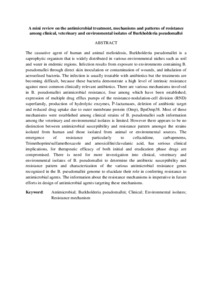Citation
Sadiq, Muhammad Abubakar and Hassan, Latiffah and Abdul Aziz, Saleha and Zakaria, Zunita
(2016)
A mini review on the antimicrobial treatment, mechanisms and patterns of resistance among clinical, veterinary and environmental isolates of Burkholderia pseudomallei.
International Journal of Livestock Research, 6 (11).
pp. 1-24.
ISSN 2277-1964
Abstract
The causative agent of human and animal melioidosis, Burkholderia pseudomallei is a saprophytic organism that is widely distributed in various environmental niches such as soil and water in endemic regions. Infection results from exposure to environments containing B. pseudomallei through direct skin inoculation or contamination of wounds, and inhalation of aerosolised bacteria. The infection is usually treatable with antibiotics but the treatments are becoming difficult, because these bacteria demonstrate a high level of intrinsic resistance against most common clinically relevant antibiotics. There are various mechanisms involved in B. pseudomallei antimicrobial resistance, four among which have been established; expression of multiple drug efflux pumps of the resistance-nodulation-cell division (RND) superfamily, production of hydrolytic enzymes, β-lactamases, deletion of antibiotic target and reduced drug uptake due to outer membrane protein (Omp), BpsOmp38. Most of these mechanisms were established among clinical strains of B. pseudomallei such information among the veterinary and environmental isolates is limited. However there appears to be no distinction between antimicrobial susceptibility and resistance pattern amongst the strains isolated from human and those isolated from animal or environmental sources. The emergence of resistance particularly to ceftazidime, carbapenems, Trimethoprim/sulfamethoxazole and amoxicillin/clavulanic acid, has serious clinical implications, for therapeutic efficacy of both initial and eradication phase drugs are compromised. There is need for more investigation into clinical, veterinary and environmental isolates of B. pseudomallei to determine the antibiotic susceptibility and resistance pattern and characterization of the various antimicrobial resistance genes recognized in the B. pseudomallei genome to elucidate their role in conferring resistance to antimicrobial agents. The information about the resistance mechanisms is imperative in future efforts in design of antimicrobial agents targeting these mechanisms.
Download File
![[img]](http://psasir.upm.edu.my/54858/1.hassmallThumbnailVersion/A%20mini%20review%20on%20the%20antimicrobial%20treatment%2C%20mechanisms%20and%20patterns%20of%20resistance%20.pdf)  Preview |
|
Text (Abstract)
A mini review on the antimicrobial treatment, mechanisms and patterns of resistance .pdf
Download (6kB)
| Preview
|
|
Additional Metadata
Actions (login required)
 |
View Item |

